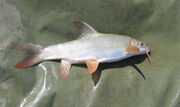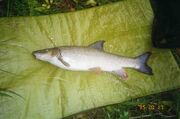
Baby barbel
The Barbel or Barbus barbus, is in the Carp Family and swims in rivers with a strong current. The Barbel will tend to 'hug' the river bed. The four whisker-like organs on it mouth called barbels, help this fish feel for food such as molluscs and

Barbel
larvae. The lower fins and tail tips are a reddish orange and the two lobes of the tail are unequal.The roe is said to be toxic. These fish can live for up to 25 years, grow up to 100cm long and weigh 14lb.
The fish is ideally suited to fast flowing waters, adult size is up to 1.2 m (4 ft) in length and 12 kg (26 lb) in weight, although it is typically found smaller (50–100 cm length, weight 1–3 kg). It is slightly laterally compressed, lacks an adipose fin, has a dark brown or grey mottled appearance, the underside is light coloured, and the fins have a reddish tinge.
B. barbus is benthopelagic, meaning they are found at the bottom of rivers as well as in open water. They are typically found feeding in deeper areas of rivers with a rocky or gravel bottom. Feeding is on benthic organisms, including crustaceans, insect larvae and molluscs.
Males become mature after three to four years, females after five to eight years, spawning occurs after upriver migration during May, June and July and 8,000 to 12,000 eggs are produced per kilogram of bodyweight.[1]The eggs are poisonous.
The name derives from "barb" giving rise to both the Scientific and Common names, B. barbus has of course, excellent examples of barbels. In English folklore the barbel was once called the pigfish.
The barbel in the UK[]
B. barbus plays a minor role in commercial aquaculture, however they are a very popular sport fish. In the UK it reaches a size of up to 21 pounds, with anything of more than 10 pounds considered to be of specimen size. Famous barbel rivers include the River Trent, Hampshire Avon, the Kennet, the Great Ouse, and more recently the River Wye, Severn, Wensum and the Teme, where the barbel was not native but has thrived after its introduction.
Such is the popularity of the barbel that angling societies exist which specifically promote the pursuit and conservation of the species.